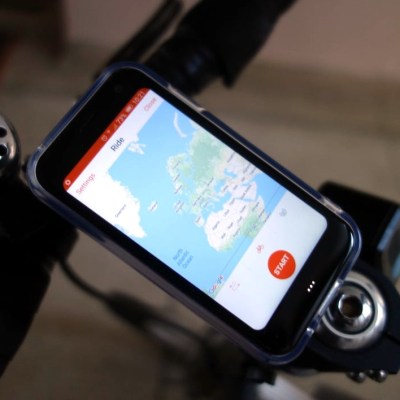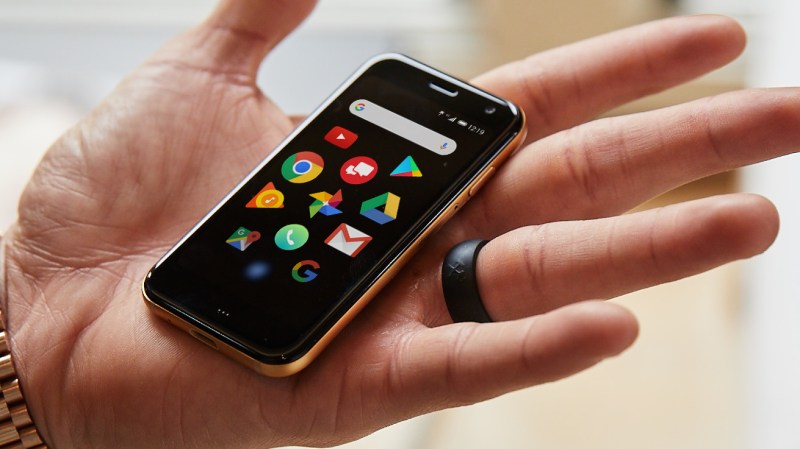The mini-mobile phone [Jim Yang] got his hands on deserves a bit of background. Palm had the concept of a companion mobile phone, and this manifested itself in late 2018 as a cute palm-sized smartphone that one could carry around when one didn’t wish to haul along their “real” phone. This smaller and simpler phone was originally intended to share the same mobile number as one’s primary phone (though it has since been made able to work as a standalone device.)

Palm’s companion phone idea hasn’t really caught on in a commercial sense, but in a way, [Jim] is validating the concept. After getting it up and running, he attached it to his bike with a custom mount to enjoy the benefits of having a mobile phone along without actually risking his primary device.
In case you’re wondering, this Palm is indeed the same Palm that launched the PalmPilot in 1996, whose distinctive folding keyboard accessory has shown up in past hacks.















Heh, I just kept all the ones I upgraded from… plus I could throw my SIM in the cheapo smert watch for an evening, it’s stellar 8 hour battery life might be good enough for that.
Nice to see this. I stopped carrying a Palm Treo 700p just last year. I used to joke that I’d be buried with one in my pocket but alas, a pocketable UNIX-based device called an “iPhone” has won my heart.
I’ll be buried with one in my pocket. Probably.
> I’ll be buried with one in my pocket. Probably.
And if the phone starts buzzing or beeping for an alert – would it be annoying?
Ah the iMaynot device, restricted in a lot of ways. How i miss my newton messagepad. :(
I would like realy Palm Os phone in 2020
OK, but how is a map of Europe, Africa, Greenland, and the North Atlantic useful when you’re on a bike?
;-)
You can look at it every couple of days to see if the marker moved a pixel.
Perhaps it’s not an option in the UK, but in the US it’s possible to buy “burner” phones from companies such as TracFone. My current cell phone cost me $7.49USD shipped, and it’s a very nice smartphone (LG Rebel 4). It replaced my previous phone ($9.99USD), which died when it fell down an elevator shaft. The phone I had prior to that cost $20, so I like where this trend appears to be heading.
How do you know it died when it fell down the elevator shaft?
Did you access the Equipment Room?
B^)
Hmmm, was it NCIS (the TV series) that made the phrase “burner phone” popular?
You can buy them at any airport in Europe and I’m guessing Asia too.
As a former Palm employee, I can attest that the Palm that released this mini-phone isn’t the Palm of yore. That Palm started independent, got bought by US Robotics which then got bought by 3Com, then was spun off in a big IPO, ended up splitting into PalmSource and palmOne, then renamed back to Palm, then was bought by HP. HP shut off their hardware business after 18 months, but kept their webOS software business for another couple of years before selling that to LG Electronics, while selling patents to Qualcomm and branding rights to TCL. This Palm is a separate venture using the TCL-owned name.
“while selling patents to Qualcomm”
Qualcomm is a patent troll who is lobbying for restoring software patents in the US via the STRONGER patent act.
A company worth boycotting, together with IBM.
Oh thank god. Been waiting for a little guide like this. I have one of those and it sucks shit as a stock phone. I don’t know why they had to make something cool like a smartphone that fits in a pack of cigarettes… and then load it up with software that—again—sucks shit. Just doesn’t work right. I’m gonna fix it!
I just picked up one of these and the instructions you posted were very helpful. I was able to get Magisk,microg, EdXposed & DejaVu Location services installed successfully. Notifications are working much better than I expected & Blockada significantly improved the battery life.
In regard to the battery life, I saw reviews that the phone would die after less than two hours of screen time. How much time did Blockada add to the battery?